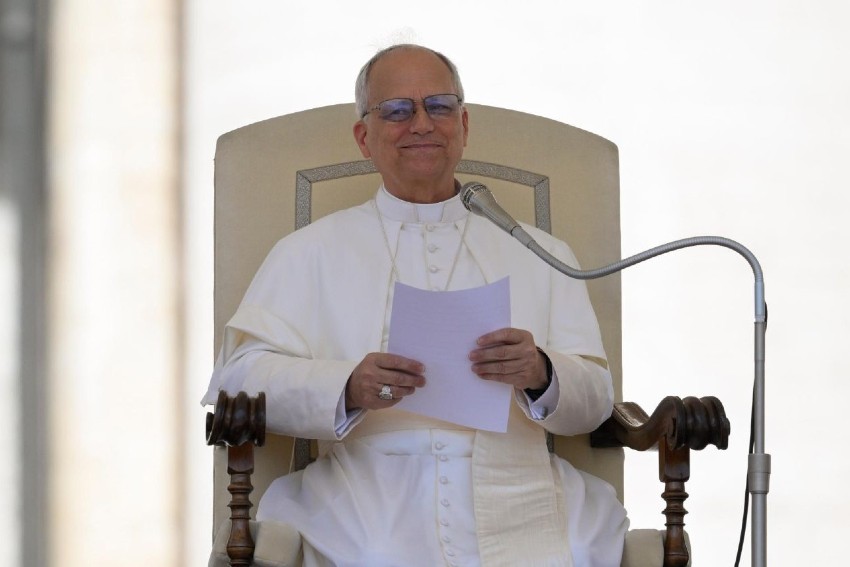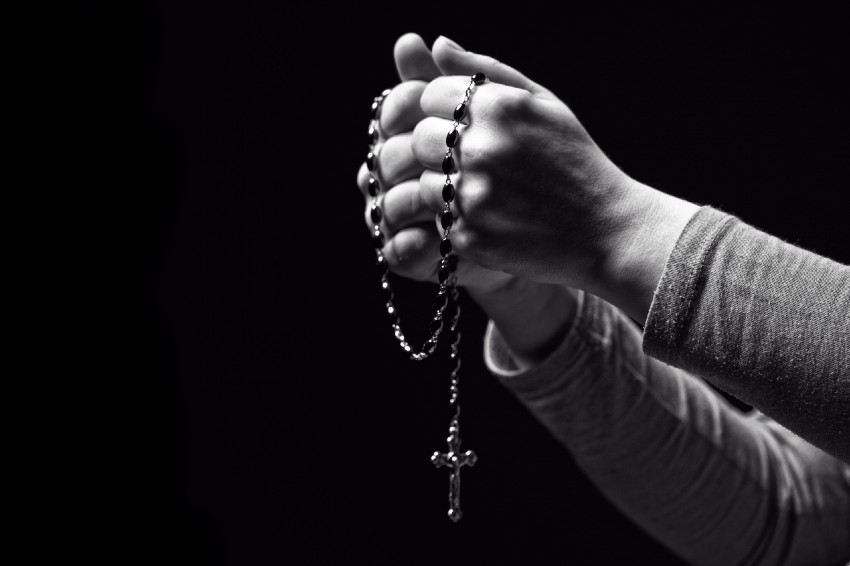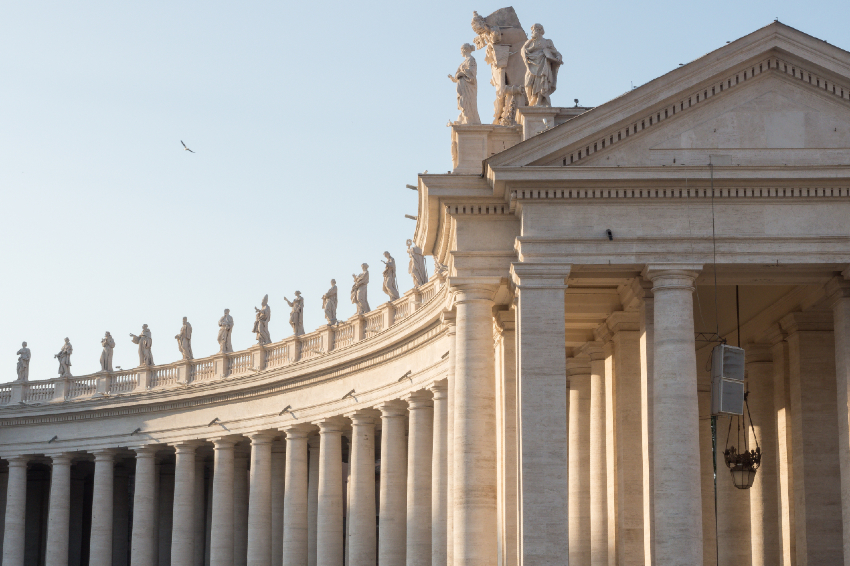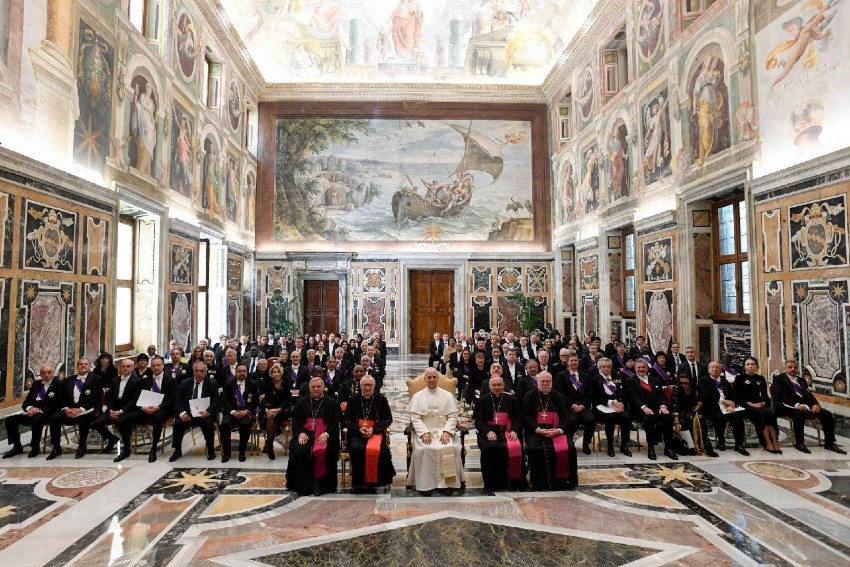
Lightning struck the cupola of St. Peter’s Basilica 12 years ago today, at about 6 p.m. on the evening of February 11, 2013, about seven hours after Pope Benedict XVI announced to his assembled cardinals that he would resign the papacy on February 28, 2013

Pope Celestine V (c. 1215-19 May 1296). Born Pietro Angelerio di Morrone, he was the 193rd Pope of the Catholic Church for less than six months in 1294, 700+ years ago. In 1232, at age 17, he became a Benedictine monk, and he was later ordained a priest. In July 1294, he was elected Pope, and in the same year, he abdicated his office. His successor, Pope Boniface VIII, confined the former Pope in the castle of Fumone, and he died there. In 1313, Celestine was made a saint by Pope Clement V

Abbot Benedict Nivakoff, 45, since the spring of 2024 the head of the Benedictines of Norcia, currently celebrating their 25th year as a monastery. (The photo was taken several years ago)
***
“After Pope Nicholas IV died in 1292, the see of Peter stood vacant for two years and three months because the cardinals and the secular rulers who were always trying to control them could not agree on a successor. By some accounts, (the monk) Peter Morrone wrote a letter admonishing the cardinals that if they didn’t elect a new Pope within four months they would face the wrath of God. Other accounts say that one of the cardinals called out that the holy monk, Peter Morrone, should lead the Church. In either case, the cardinals responded by electing Peter as Pope. At the time he was elected, Peter’s order had six hundred monks. He was the first founder of an order to be elected Pope.” —A description of the election in 1294 of a monk who lived according to the Rule of St. Benedict, Peter de Morrone, to succeed Pope Nicholas IV. The monk the cardinals chose took the name of Celestine V, but after only five months as Pope, he resigned, on December 13, 1294. He died two years later, in 1296, and was canonized as St. Celestine V in 1313 by Pope Clement V, though Dante in his Divine Comedy (written just a few years after these events) accused Celestine of being cowardly, and called his decision to step down from his office “the great refusal.” No other Pope has ever voluntarily stepped down from the papacy, except Pope Benedict XVI, who announced he would resign on February 11, 2013, 719 years after Celestine V resigned. (link) That announcement came 12 years ago today, and in the evening of that day, torrential rains poured down in Rome, and the dome of St. Peter’s basilica was struck by lightning
Letter #23, 2025, Tuesday, February 11: Next Papal Election
Pope Benedict XVI resigned 12 years ago today, on February 11, 2013…
It was the first such papal resignation since Pope Celestine V in 1294.
That evening, amid cold, torrential rain (I myself was in and near St. Peter’s Square that evening) lightning struck the dome of St. Peter’s basilica (photo below).
Pope Francis was elected about one month after the resignation, on March 13, 2013.
Now, as Francis is 88 and suffering from various ailments, though still evidently strong in will, some are turning their thoughts to the question of who might be chosen as Francis’ successor… as the next Pope.
Could the cardinals in conclave even decide, once again, to elect, not one of their number, but a holy Benedictine monk? —RM
P.S. To subscribe to Inside the Vatican magazine, click here.
THE NEXT POPE
By Charles Parlato
February 11, 2025 — Feast of Our Lady of Lourdes
The temper of the times
The next Pope will probably be determined in the next 2 years.
This selection by the College of Cardinals will be made in a world where constant criticism, instant judgement, and unremitting noise shape the boundaries of all decisions.
It is a world where the loudest, most persistent, self-satisfied combatant is hailed as rightful leader/president/commissar.
The essence of the new Pope
Our world is badly in need of a leader who radiates a spirit and persona in contradiction to the temper of the times.
The Church must raise up a leader that the world will instantly recognize, as first and foremost, a man of contemplation, devotion, prayer, and obedience.
He must be seen by the world as a man who has been molded by the Holy Spirit, not by worldly attributes such as “brilliant”, “well-read”, “articulate”, “highly educated”, “well-traveled”.
The new Pope might check all of those boxes as well, but he must be known first as one imbued by the Holy Spirit and as a devoted and obedient follower of Jesus.
These traits must be clear and unassailable.
The college of cardinals
The members of the College of Cardinals are viewed by the world as the hierarchy or royalty of the Roman Catholic power structure.
In the modern game of charge and counter-charge, the competence and motivation of the princes of the Church, like all political leaders, are constantly questioned and attacked.
This modern process undermines the Pope’s and, thereby, the Church’s moral and teaching authority.
Under these conditions, the Roman Catholic Church simply becomes another political roadblock to those who profess modernity as salvation.
The Roman Catholic Church, like all pillars of Traditionalism, must, therefore, be destroyed, or at least substantially diminished, if secularism is to advance.
A Catholic leadership that is clearly identifiable as Spirit- and Jesus-led will greatly reduce the likely success of secularism’s goal.
While it is certainly true that many, if not most, of the 20th and 21st century pontiffs, coming from the Church hierarchy, were men of great devotion and prayer, those traits were seldom noted or recognized outside of the Church.
What has always been known by the world is the Church’s political standing and power.
If the Church desires to lead the world toward a new era of Christian belief and morality, the Roman pontiff must be seen as humble and Spirit-led by that world.
New geopolitical conditions
The American political year has thrown a bright light on the true heart of the world.
The world is returning to Traditionalism as a ruling philosophy.
The Collectivist mind, which groups the minds, hearts and needs of people based on ethnic, racial, and economic characteristics, is losing every aspect of the sociological and political debate to the Individualist mind, which categorizes people according to their individual moral choices.
This Individualist mind recognizes that the well-being of communities depends on the moral choices individuals make.
Jesus Christ demands that His children make moral choices.
Christianity fulfills the needs of The Individualist mind, and as this truth becomes more apparent, more hearts will be turned toward Christ.
The more Christ-like the Church is, the more people will seek to enter its doors.
To a large degree, the image of the Church depends upon the image of the pontiff.
Most importantly, the image must reflect the reality.
Scripture points the way:
Jesus: “Take up my yoke and learn from me, for I am meek and humble of heart, and you will find rest for your souls.” (Matthew 11:29)
“For Moses was a man exceedingly meek above all men that dwelt upon the earth.” (Numbers 12:3)
“And the meek shall increase their joy in the Lord, and the poor men shall rejoice in the Holy One of Israel.” (Isaiah 29:19)
There are other geopolitical facts that should be considered by the College of Cardinals.
Foremost is the undeniable truth that the United States is the predominate economic, military and political power in the world, and English is the world’s “universal language”.
A Pope whose native tongue is the universal language will more easily and effectively communicate the faith to the world without mistake or misunderstanding.
Finally, the United States has the 3rd largest Catholic population in the world, and the Americas have the largest total Catholic population of any region by far.
The next Pope
Respectfully, I submit to the College of Cardinals that the College should consider selecting a committed priest who is an abbot of a monastery, who is young, who has dedicated his adult life to Jesus and His Church, who was raised as an American and who fluently speaks, at a minimum, Italian, Latin and English.
Most importantly, like Jesus, he must be “meek and humble of heart”.
Such a man resides in Norcia, Italy, as the Abbot of the Benedictine Monks of Norcia, Italy.
Rt. Rev. Dom Benedict Nivakoff is a man who was raised and educated in the United States and has lived his entire adult life in the monastery of St. Benedict in Norcia, Italy. Although he is now almost more Italian than American, he has maintained close ties to his homeland.
Father Benedict is young (45) with an abundance of energy to be applied to the physical and intellectual tasks before him. He is opposed to all that is bad and contrary to the Lord’s Holy Church. He will revive the beauty and power of the rituals and liturgies of the Church, and that beauty will draw mankind. The commandments and precepts of the Church will be clearly pronounced, understood, and followed by the faithful.
The world badly seeks moral leadership. Fr. Benedict will provide comfort and direction to our troubled and confused world and clarity for the mission of the Church.
Jesus looked at them and said, “With man, this is impossible, but with God all things are possible.” (Matthew 19:26)
(Fr. Benedict knows nothing about this article and has never been approached about this subject.)
Respectfully submitted,
Charles Parlato

An image of Abbot Benedict Nivakoff, O.S.B, on the cover of an album of Marian chants by the Benedictine monks of Norcia, Italy (link).
Inspiring, beautiful music of Chant at it’s very best, by the beloved Monks of Norcia, Italy. BENEDICTA: Marian Chant from Norcia is a glorious recording of 33 tracks of Gregorian chant, that transports the listener to the Monks’ idyllic monastery in Italy.
The stunning album includes favorite Marian antiphons such as Regina Caeli, Salve Regina, Ave Maria and Ave Regina Caelorum, but also previously unrecorded chant versions of responsories, and a piece originally composed by the monks (Nos Qui Christi Iugum).
Some pieces are sung by the entire group, some by smaller ensembles of monks and others by soloists, imbuing BENEDICTA with a vast range of sound and color. Recorded on location at the monastery in Norcia, Italy, the album was produced by 11-time Grammy Award-winning producer Christopher Alder and engineered by Grammy-Award winning engineer Jonathan Stokes.
***






Facebook Comments